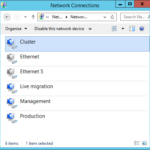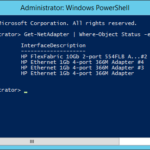This article is not part of the Building Microsoft System Center Cloud series but we will use the new cluster to host our VMs in the cloud series.
Network adapter interfaces
Rules
- It is a crucial to set correct configuration for the network.
- Do not disable IPv6. It is recommended that IPv6 is left bound to all NICs even if you do not actually set IPv6 addresses. Also if you disable IPv6 on the interfaces on the network adapters you will not disable IPv6 in the operating system. It is not possible to disable IPv6 in Microsoft Windows Server 2012 operating system.
Interfaces
- Management
- Descriptions
- Direct connection of the nodes.
- Configurations
- Register in DNS: Yes
- LMHOSTS lookup: No – Never!
- NetBIOS over TCP/IP: No – Never!
- Descriptions
- Production
- Descriptions
- VMs connectivity
- Hyper-V Extensible Virtual Switch
- Descriptions
- Cluster
- Descriptions
- Inter-cluster communication also known as heartbeat (incorrect name).
- Configurations
- Register in DNS: No
- LMHOSTS lookup: Already configured during setting first interface (No)
- NetBIOS over TCP/IP: No – Never!
- Descriptions
- Storage
- We do not have it.
- Same configuration as previous.
- Live migration
- Configurations
- Register in DNS: No
- LMHOSTS lookup: Already configured (No)
- NetBIOS over TCP/IP: No – Never!
- Configurations
- Backup or Replica traffic
- We do not have it.
- Same configuration as previous.


- In the production environment you would need to configure NIC teaming for the production network (Virtual or Logical Switch for the VMs) but in my test environment I am limited in the amount of cables (it is blade server so there not actually cables) so please forgive me that I will not show you the exciting new teaming configuration that Microsoft gave us in Windows Server 2012.
Binding order and configuration in Failover Cluster Manager
- Management
- Failover Cluster Manager
- (o) Allow cluster network communication on this network
- [x] Allow clients to connect through this network
- ( ) Do not allow cluster network communication on this network
- (o) Allow cluster network communication on this network
- Make sure to configure the NIC in the Failover Cluster Manager to allow cluster network communication on this network so the network will be secondary inter-cluster communication network (heartbeat).
- Failover Cluster Manager
- Production (VMs connectivity)
- Failover Cluster Manager
- There is no interface on management partition so the network is not visible in Failover Cluster Manager.
- Failover Cluster Manager
- Cluster
- Failover Cluster Manager
- (o) Allow cluster network communication on this network
- [ ] Allow clients to connect through this network
- ( ) Do not allow cluster network communication on this network
- (o) Allow cluster network communication on this network
- Failover Cluster Manager
- Storage
- We use Fibre Channel so we do not have iSCSI or SMB 3.0 network but if we have it.
- Failover Cluster Manager
- ( ) Allow cluster network communication on this network
- [ ] Allow clients to connect through this network
- (o) Do not allow cluster network communication on this network
- ( ) Allow cluster network communication on this network
- Live migration
- Failover Cluster Manager
- (o) Allow cluster network communication on this network
- [ ] Allow clients to connect through this network
- ( ) Do not allow cluster network communication on this network
- (o) Allow cluster network communication on this network
- Failover Cluster Manager
- Backup
- Failover Cluster Manager
- (o) Allow cluster network communication on this network
- [x] Allow clients to connect through this network
- ( ) Do not allow cluster network communication on this network
- (o) Allow cluster network communication on this network
- Failover Cluster Manager
- Replica traffic
- Failover Cluster Manager
- (o) Allow cluster network communication on this network
- [x] Allow clients to connect through this network
- (o) Do not allow cluster network communication on this network
- (o) Allow cluster network communication on this network
- Failover Cluster Manager
